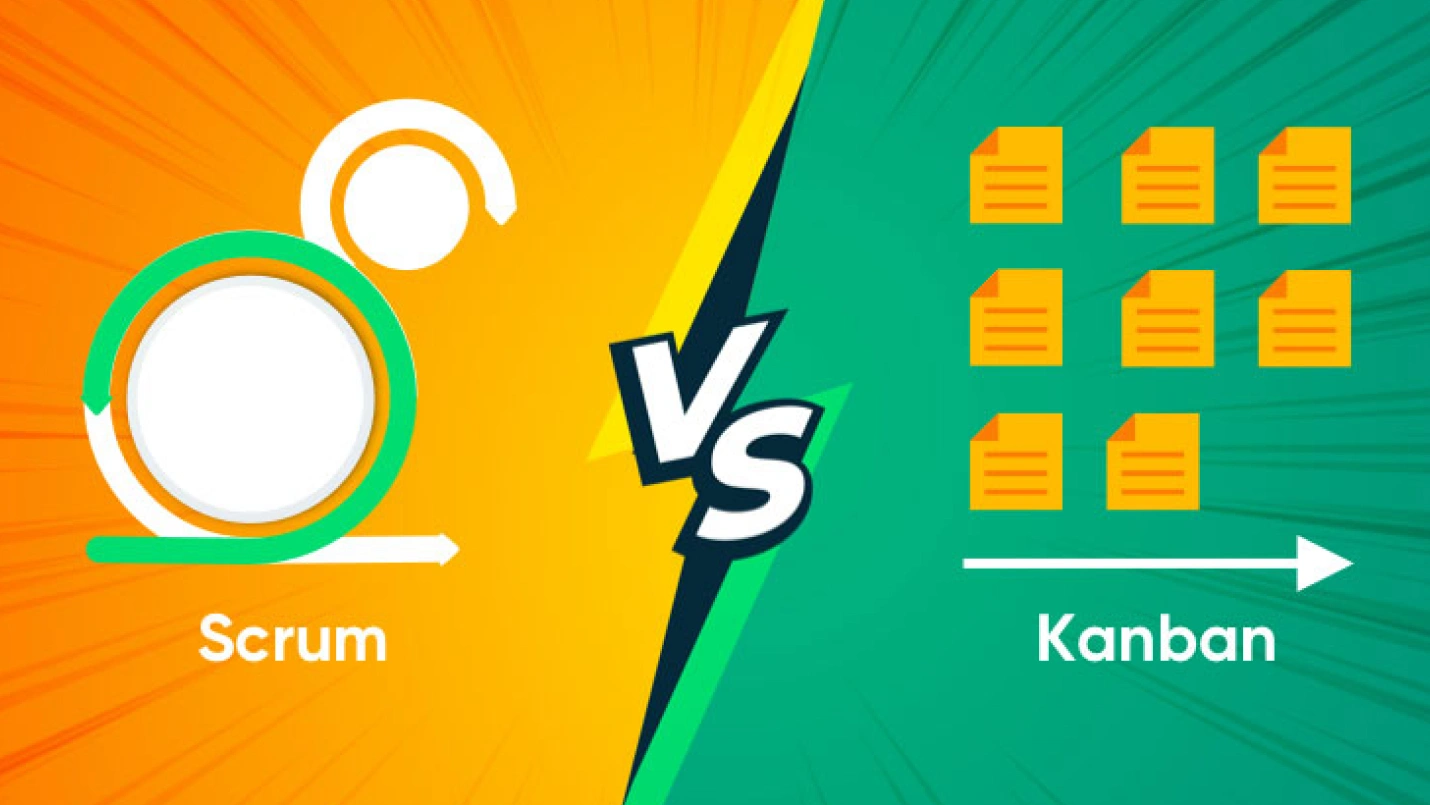Summary:Kanban vs Scrum discusses two different agile software development approaches. Practices are different, but principles remain the same. The only winner between Kanban and Scrum is the one that best suits your business.”
Agile, Scrum, and Kanban – all these terms are closely related. Agile is a set of principles for building better products at speed and scale. Kanban and Scrum are ways to manage the software development process.
Differentiating between Kanban and Scrum is easy if you look at the surface level. However, as you dig deeper, things quickly become confusing.
Both Kanban and Scrum practices are different, yet follow the same principles. Even the end goal remains the same, i.e., building digital products with the right balance of stability and speed. Adding to the confusion, both Kanban and Scrum are used interchangeably. You might have seen teams using Kanban boards for Scrum.
So, how would you differentiate Kanban and Scrum, and decide which approach is the best for your business?
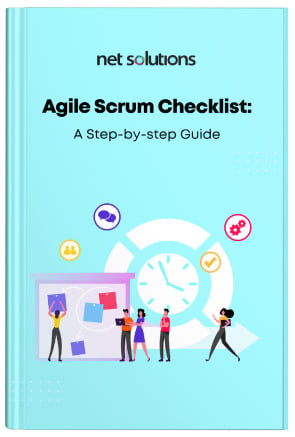
We respect your privacy. Your information is safe.
A Brief Introduction to Agile, Scrum & Kanban
Here’s an overview of Agile, Scrum, and Kanban:
a. Agile
is a de facto, iterative approach to build and deploy products to enable continuous delivery. Its foundation lies in building self-organizing teams that learn and make quick adjustments at every step to produce and deliver software faster.
b. Scrum
Scrum is an agile framework for developing, delivering, and maintaining products in a complex environment. It allows teams to build products iteratively & incrementally and respond to changes effectively, quickly, and efficiently.
c. Kanban
Just like Scrum is another Agile development methodology that aims at creating a visual process framework to build products faster by limiting work in progress (WIP). Kanban Agile methodology aims to make sure that the small independent tasks move to the next steps swiftly to realize business value faster. The Kanban method is a popular approach to project management that originated in Japan. The Kanban method is highly adaptable, allowing teams to change their workflow easily. This makes it well-suited for fast-paced, dynamic work environments.
Kanban vs. Scrum: What is the Difference?
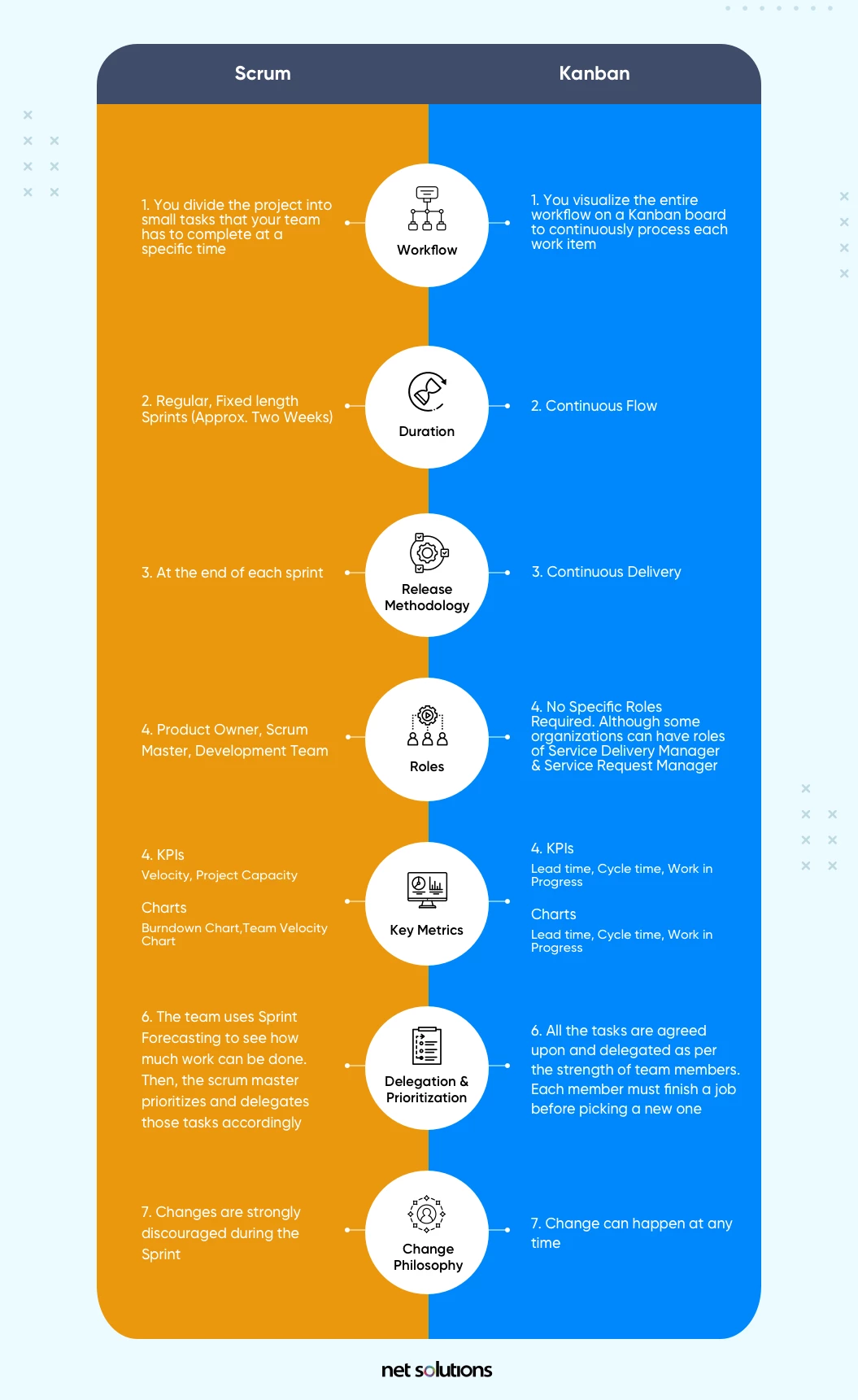
1. Kanban vs. Scrum: Principles
The Kanban approach focuses on optimizing and managing workflows. It operates on six core principles that we can further divide into two types.
a. Kanban Principles
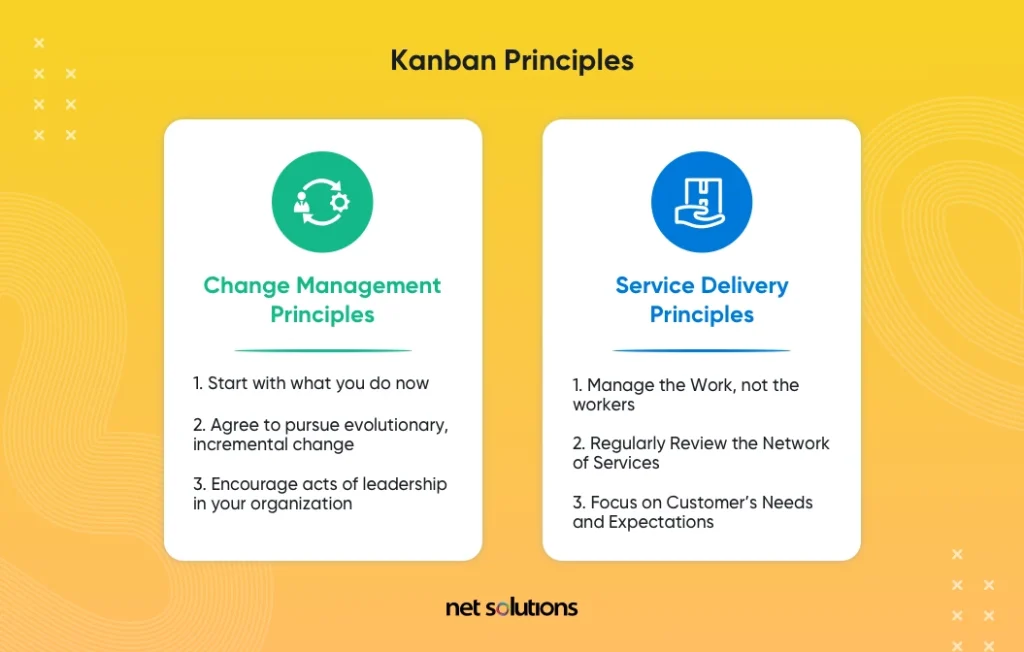
b. Scrum Principles
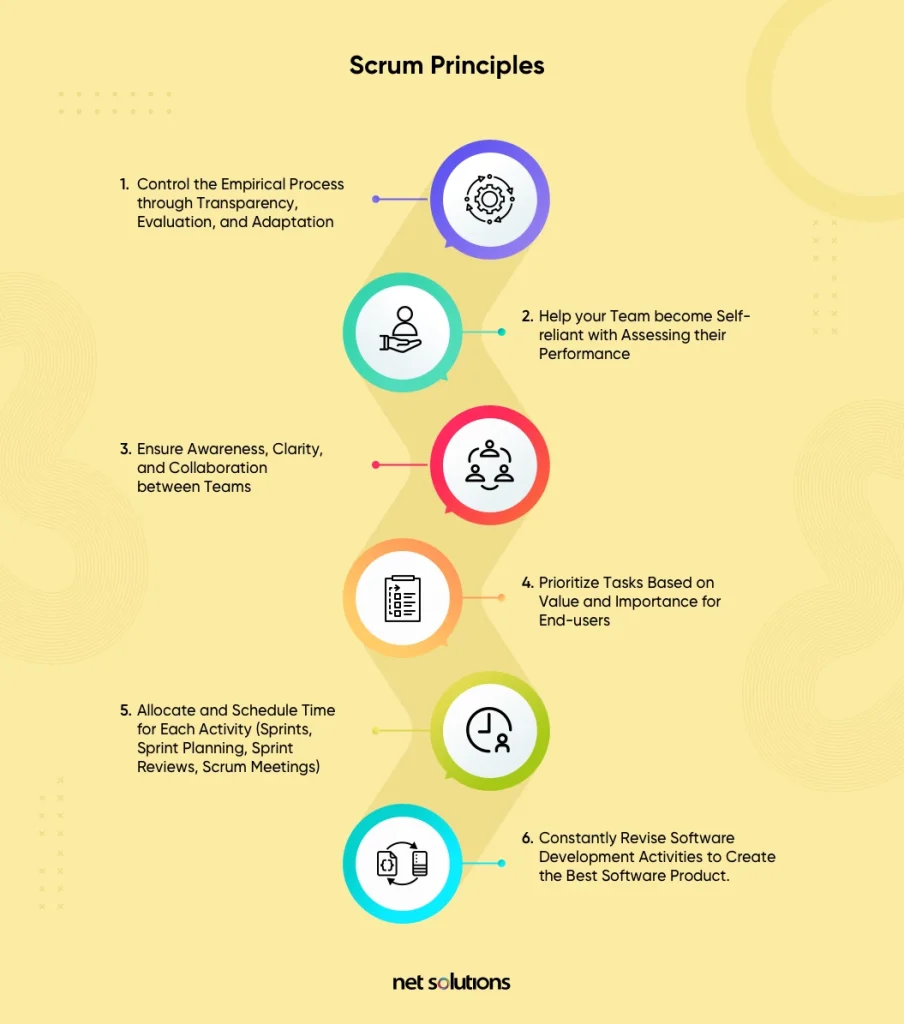
Overall, transparency, inspection, and adaptation are three strong pillars on which the entire scrum development approach is based.
2. Kanban vs Scrum: Frameworks
a. Kanban Framework
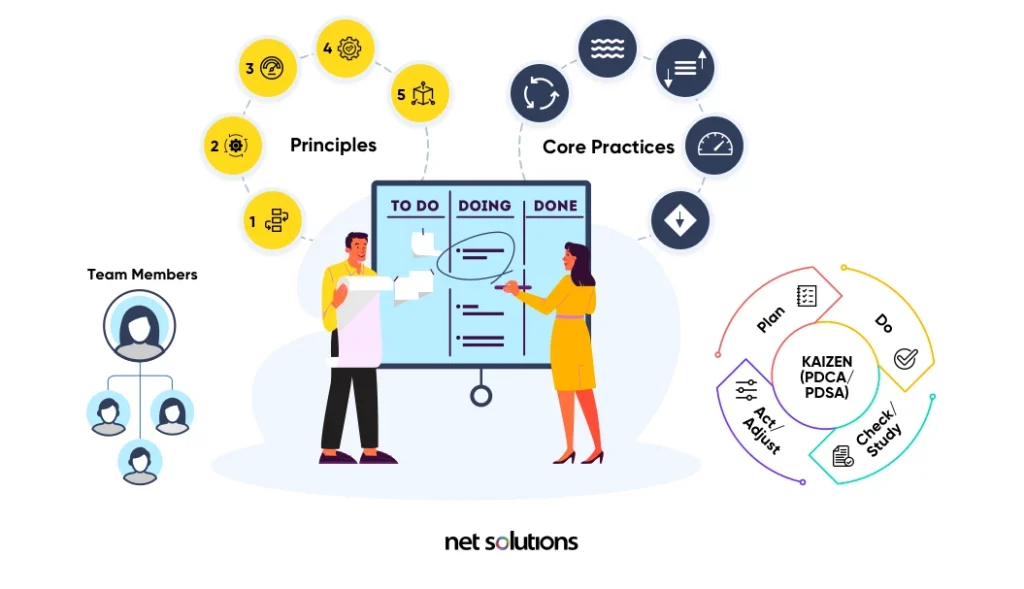
Team members, principles, and core practices play a crucial role in the Kanban framework. Also, there are models to identify the scopes for improvement. Here’s how we incorporate the Kanban framework in the product development process:
- Kanban is based on a continuous workflow structure. When the self-driving team has the capacity, they pull the new work from the work-item pool (work items are represented by cards organized on the Kanban board).
- ‘To-Do’, ‘Work in progress’, and ‘Done’ are the standard workflow stages. However, you can create custom columns based on your team’s work.
- Compared to Scrum, which is dependent on daily planning/feedback sessions, the Kanban technique is independent of daily stand-ups and is carried out only when necessary.
- Incorporating Kanban principles demand a good level of discipline and self-awareness (found missing on teams new to Agile).
b. Scrum Framework
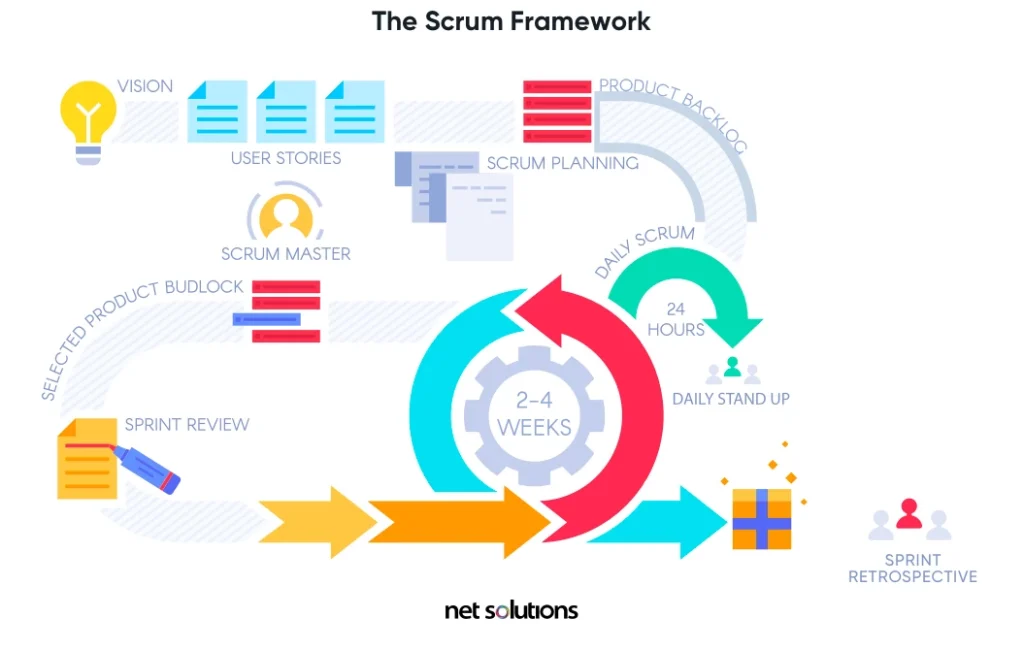
The following is the way we incorporate the Scrum framework in the product development process:
- The project kick starts with a clear set of requirements provided by the business.
- The product features are aligned in order of importance and become part of the product backlog (maintained by the Product Owner).
- We decide the number of sprints required to complete the selected features (ranges from 1-4 weeks).
- The self-organized team picks tasks from the product backlog that can be completed in the given sprint and begins the task work.
- The team focuses on meeting the sprint goals; thus, they are protected from interruptions.
- We can never change the sprint backlog. However, while preparing for the next sprint, we can change the product backlog.
- Within each sprint, the team meets for 15 minutes to discuss the daily progress. It is called a Scrum meeting.
- At the end of each sprint, the team gathers feedback based on which their next week’s sprint depends.
3. Kanban vs Scrum: Roles & Responsibilities
a. Kanban Roles
The Kanban approach has no specific roles. The whole team owns the process instead, and it is the responsibility of each team member to work collaboratively. You may have an Agile coach within your team, but there is no ‘Kanban master’ as in Scrum, which ensures that the team strictly follows all the principles.
Note: Some organizations that follow the Kanban approach have two roles called Scrum Delivery Manager and Scrum Request Manager these days. But they’re entirely optional.
b. Scrum Roles
On the other hand, the Scrum Approach has three clearly defined roles within a team: the Product Owner, the Scrum Master, and the Development Team.
- The Product Owner serves as the voice of the customer and communicates their vision to the team. The product owner owns the product backlog and works with the team daily to help prioritize their work.
- Scrum Master: A Scrum Master strictly ensures that the team follows the Scrum principles. Scrum Master facilitates team communication & collaboration, removes bottlenecks, and acts as a spokesperson of the self-organizing team.
- Development Team: The development team owns the product delivery: they deliver increments, make task commitments, and meet daily to track the work status in the daily Scrum.
4. Kanban vs. Scrum: Planning
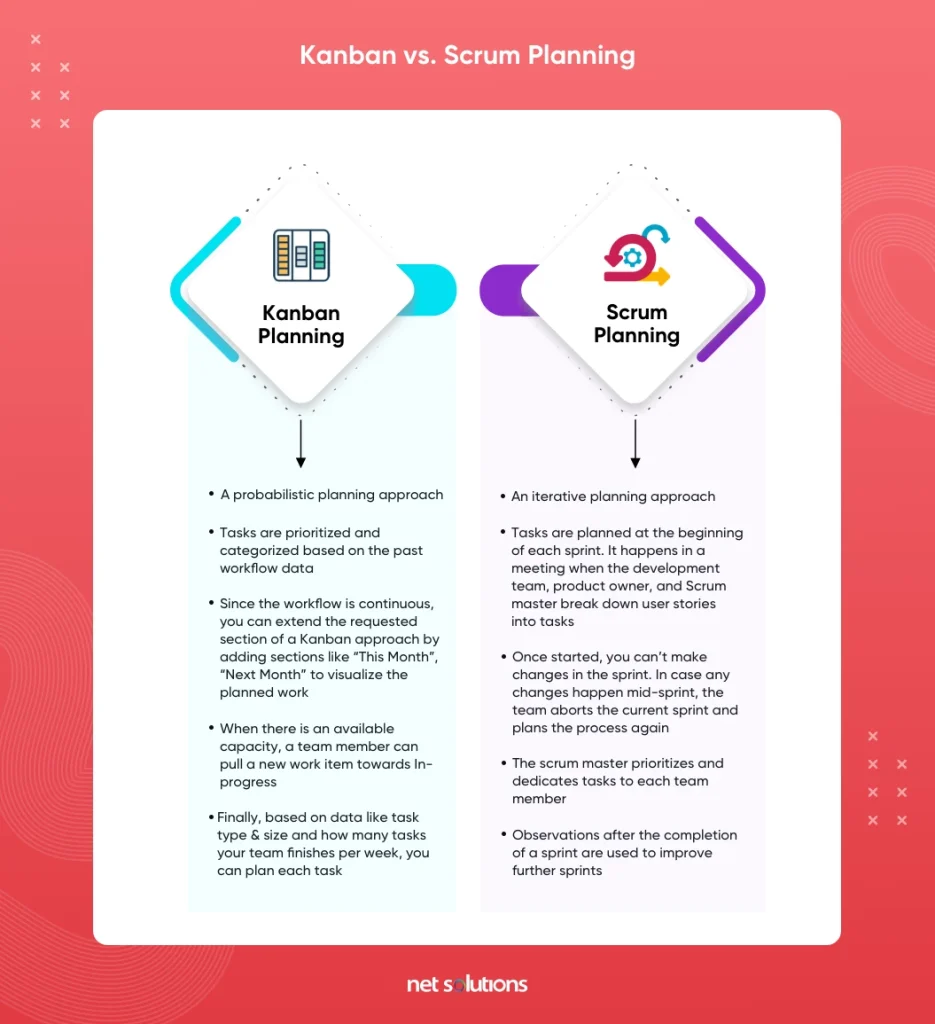
5. Kanban vs. Scrum: Commitment
The Kanban approach favors agility and delivering value on time. Therefore, we decide on the commitment in Kanban based on the team’s capacity. Each team member commits to finishing the task he started before picking a new one. The Kanban method focuses on managing and limiting the amount of work in progress, which can help teams avoid multitasking and reduce the amount of time spent on non-value-added activities. This can lead to increased efficiency and productivity.
On the other hand, commitment is decided using Sprint Forecasting in Scrum. The scrum team predicts how much work can be done and then meets the deadline. The problem with this approach is that if the team fails to anticipate its capacity accurately – either the sprint fails, or you need a lot of effort to finish it on time.
6. Kanban vs. Scrum: Board
Both Kanban and Scrum approaches use a visual board to track work progress. However, there are significant differences between both.
a. Kanban Board
The Kanban board helps track the workflow structure while balancing the number of work-in-progress activities. The quantity of work-in-progress items is not significant and avoids including unworthy tasks.
Kanban is like a relay race, where one handover equals one point, and the team’s mission is to minimize the time between the handovers.
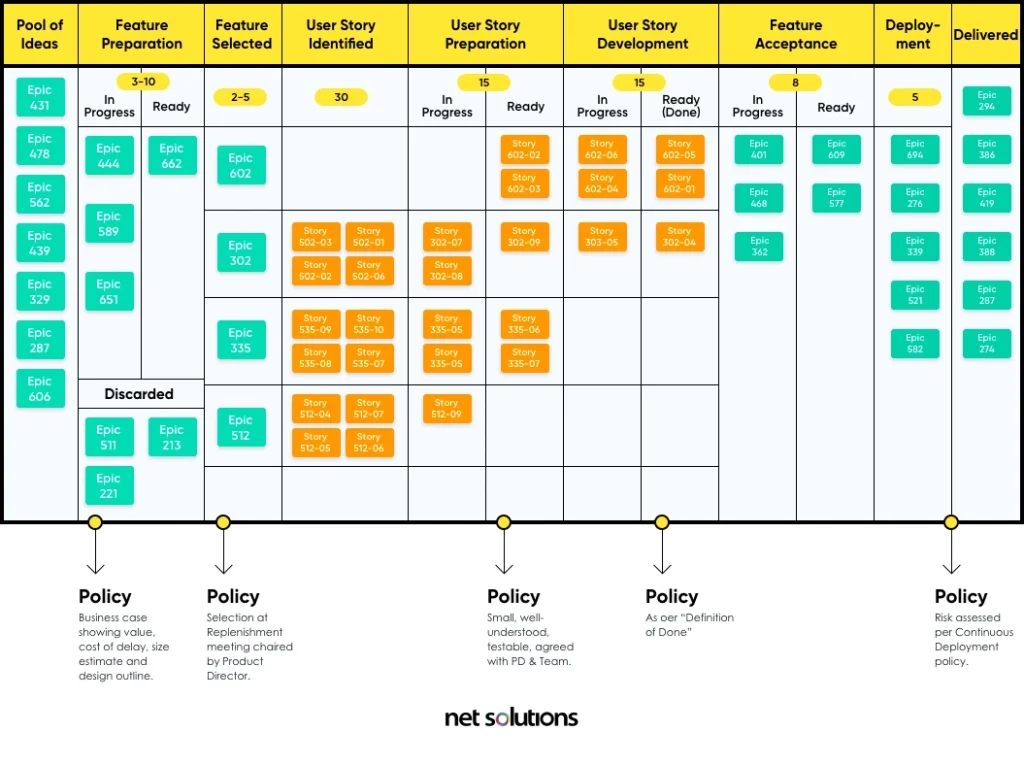
b. Scrum Board
The Scrum board is an extension of the product backlog where the team commits to the work. After adding the work to the Scrum backlog, the team starts putting the work in progress as per their convenience. The end goal of a Scrum board is to get everything done by the end of the sprint.
Scrum is like an exam: you will have to cover/complete your entire syllabus (backlog items) within a certain period. Crafting a Scrum board is like preparing for an exam: a tool that helps identify what needs to be done and how to organize your schedule and group.
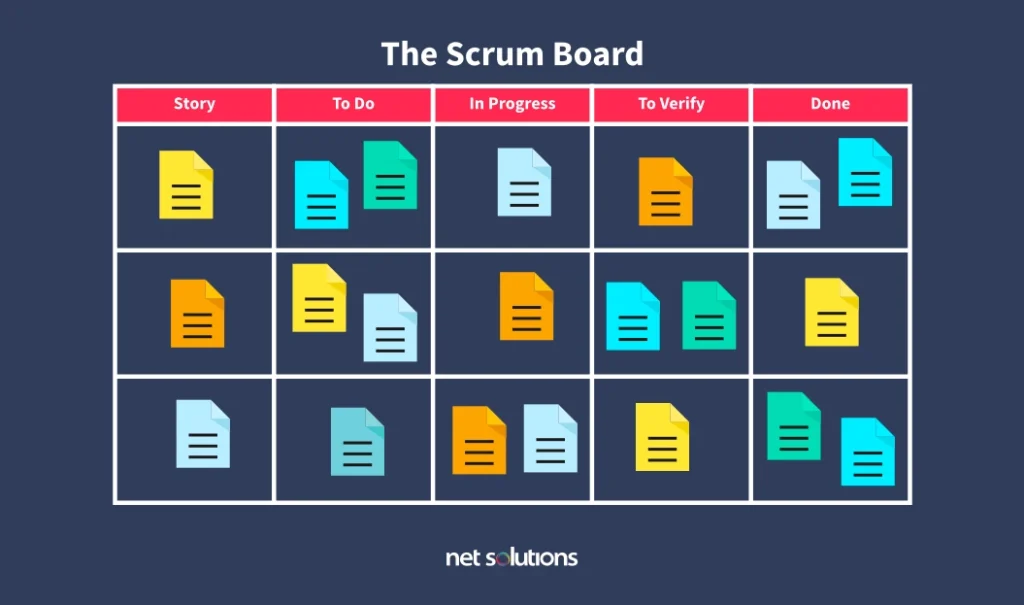
7. Kanban vs Scrum: Meetings
| Kanban Meetings | Scrum Meetings |
|---|---|
| Meetings are optional yet highly recommended in Kanban as they keep your team aligned and workflow steady.fraud | Meetings are mandatory in Scrum. |
| Types of meetings in Kanban:
Daily Meetings. Replenishment & commitment Meeting. Delivery Planning Meetings. Service Delivery Review. Operations Review. Risk Review. Strategy Review. |
Types of meetings in Scrum:
Sprint Planning. Daily Scrum. Sprint Review. Sprint Retrospective. |
| You can combine or skip the Kanban meetings you don’t deem necessary. | All the Scrum meetings are necessary, and you must not skip any of them. |
8. Kanban Vs. Scrum: Key Metrics
a. Key Metrics in Kanban
Lead time and cycle time are the critical Kanban team metrics that help examine the team’s amount of time to complete a task from scratch to finish. Improved cycle times lead to the success of Kanban teams. Another important thing to notice is that the Kanban method is a pull system – this means that the work or responsibilities are pulled into the system when the team has the capacity for it. However, the scrum methodology goes the other way.
Another metric Kanban teams use to analyze their performance is the Cumulative Flow Diagram (CFD). It helps teams measure and understand the progress of workflow/items and bottlenecks in each phase that need to be rectified for better throughput.
You can even calculate the ideal Kanban team size by assessing the expected WIP and throughput. Some of the critical metrics and calculations are in the following figure:
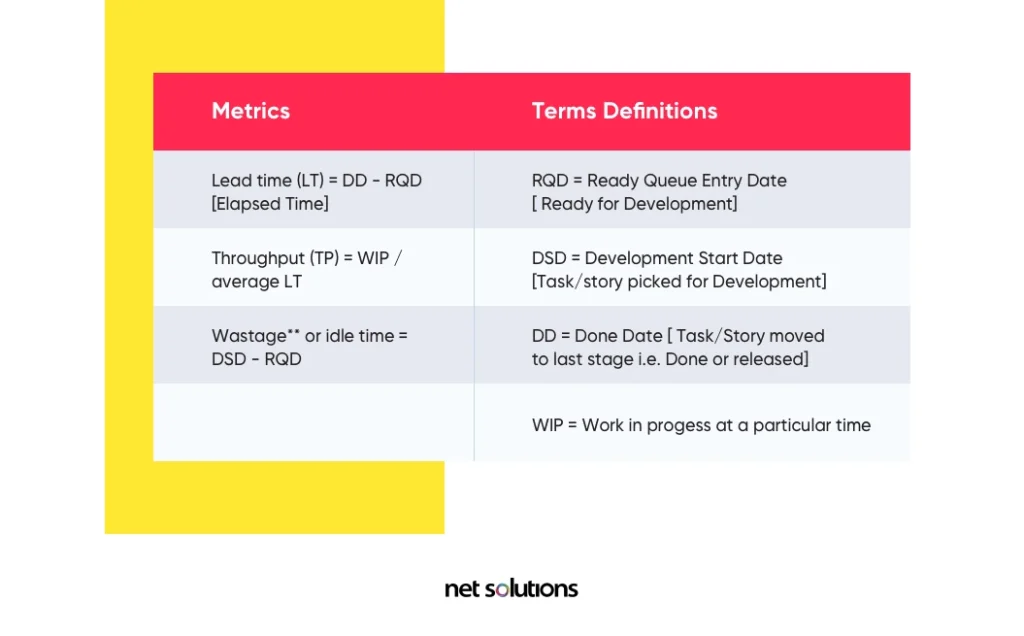
b. Key Metrics in Scrum
The most important metric for Scrum teams is Velocity. It defines the number of story points completed in a specific sprint. Based on the number of completed story points, the commitment for the future sprints is laid out.
For example, if a self-organizing team finishes 15 story points per sprint, it implies Velocity is 15. Hence, the team won’t be comfortable with a sprint backlog that contains 25 story points.
Remember, trying to artificially boost Velocity can break trust and reduce transparency between team members and management.
9. Kanban vs. Scrum: Tracking Progress & Analyzing Work
We track the work progress in Kanban using a cumulative flow diagram (CFD) that measures data for each task that enters the workflow. It helps users visualize both the work items and the time they spent in specific work stages.
Then, we use this data to measure the cycle time for each work time, i.e., the total amount of time we spent finishing a task. As a result, we can quickly identify problems in our workflow and fix them on time instead of getting notified of them later.
Burndown chart is the metric we use to track the work progress in Scrum and see if everything is going as per plan. It is a fundamental performance indicator that shows how much work is left in a given time. When something is wrong, you will see a drop in the total work finished.
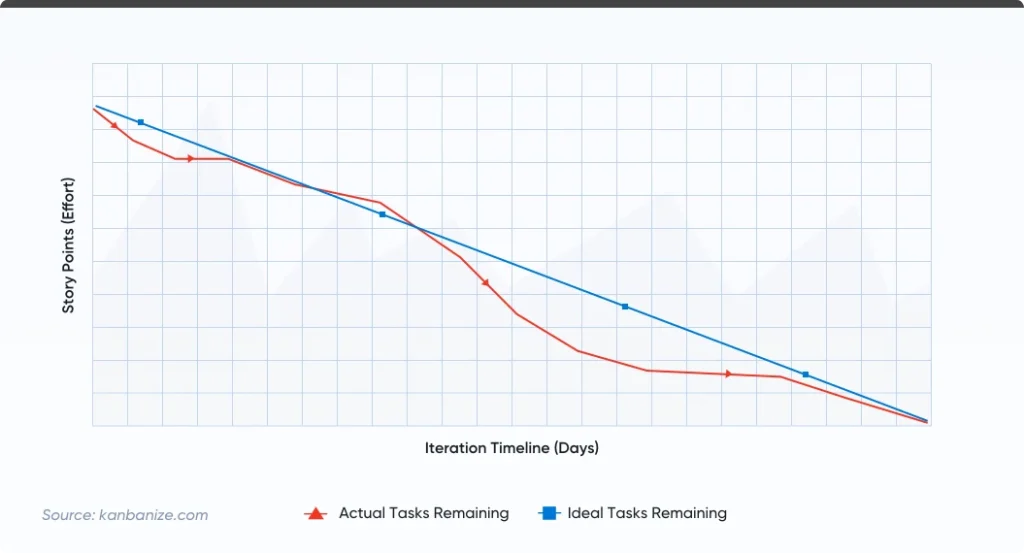
However, Scrum will only indicate a drop in overall performance. It’s up to you to discover the root cause of the drop because Scrum tools will not indicate the true roadblock of your project.
10. Kanban vs Scrum: Advantages & Disadvantages
a. Kanban Advantages & Disadvantages
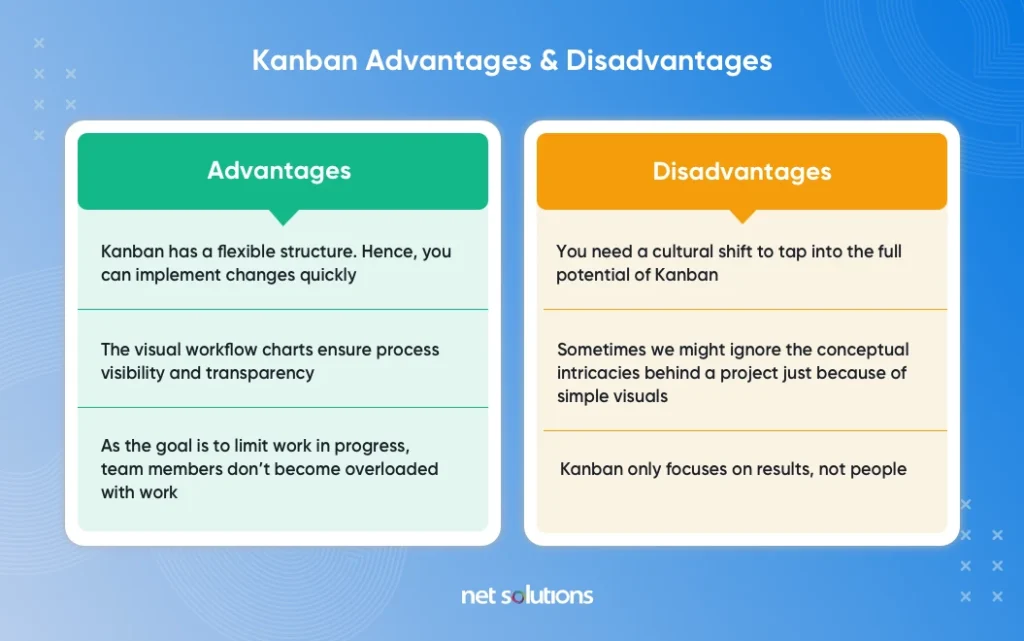
b. Scrum: Advantages & Disadvantages
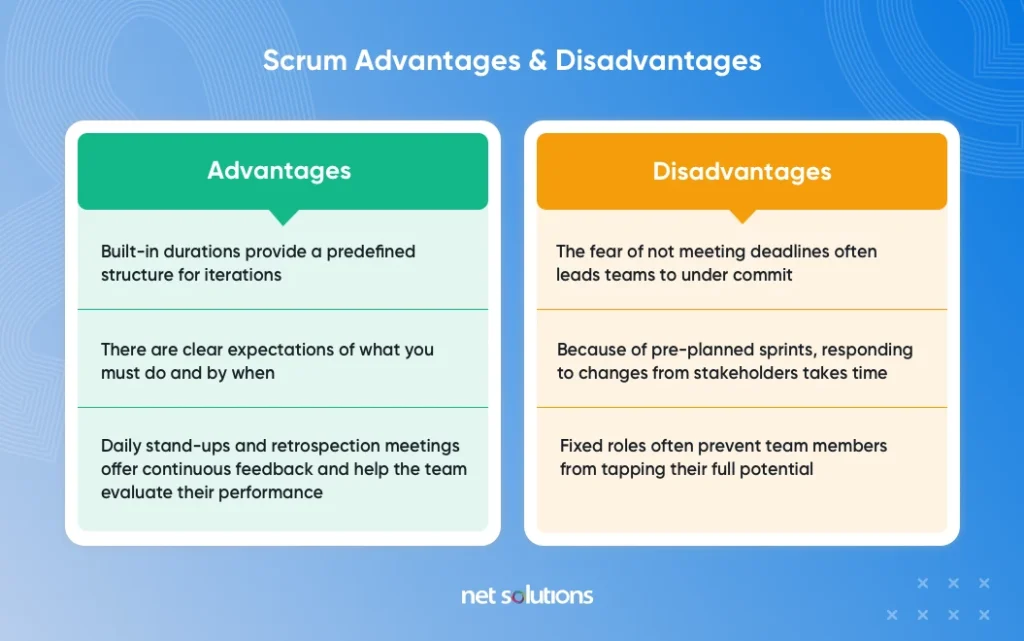
Scrum vs Kanban: Which is a Better Choice?
There is no clear winner among Kanban and Scrum. Based on your team, each approach can boost your efficiency and productivity.
When Should You Use Kanban?
- You want to implement a workflow without affecting your existing workflow.
- You have a largely repeatable work process.
- Your project is simple and easy to understand.
- You want to limit planning and meetings and focus on delivery instead.
- You want to deliver features and improvements continuously instead of fixed releases.
- Overall, Kanban method is a powerful tool that can help teams improve their workflow and achieve their goals more efficiently and effectively.
When Should You Use Scrum?
- You have a self-motivated team that believes in collaboration.
- The project requirements keep changing.
- The client is open to innovation and adapts to change.
- You want to build many features and need a plan to figure out how much time they will take.
- Your project is complex and involves a deeper level of understanding.
In a Nutshell:
- Use Kanban for small tasks like fixing issues or small enhancement requests.
- Use Scrum for feature-driven goals with significant milestones.
- But feel free to combine things and take the Scrum-ban route, i.e., use Scrum and apply great Kanban ideas around visual management boards and minimize work in progress (WIP).
Frequently Asked Questions
Both Scrum and Kanban are agile processes. While Scrum focuses on delivering business value in the shortest time, Kanban is a visual system for managing the software development process that fosters continuous improvement, efficiency, and productivity.
It is possible to combine both Kanban and Scrum. That’s what most agile teams are doing these days. They follow the Scrum-ban approach in which they use Scrum and borrow some Kanban ideas. Doing so will ensure you can reap the benefits of both worlds.
Since the Kanban approach favors a horizontal hierarchy, it has no product owners, and the entire team owns the product instead. Still, if the situation demands, you can create this role.
Kanban is a specific implementation of lean, and it has lightweight frameworks compared to heavy-weight systems like CMMI and RUP. The Kanban board is an agile management tool that helps you visualize work, limit work-in-progress, and maximize efficiency.
Agile is a set of principles for building better products at speeds. Scrum and Kanban are two ways to do that. In simple words, both Scrum and Kanban are the subset of agile.

